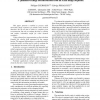Free Online Productivity Tools
i2Speak
i2Symbol
i2OCR
iTex2Img
iWeb2Print
iWeb2Shot
i2Type
iPdf2Split
iPdf2Merge
i2Bopomofo
i2Arabic
i2Style
i2Image
i2PDF
iLatex2Rtf
Sci2ools
AIPR
2001
IEEE
2001
IEEE
A Qualitative Image Reconstruction from an Axial Image Sequence
This paper presents a method to process axial monocular image sequences for mobile robot obstacle detection. We do not aim to achieve a complete scene reconstruction, but only to evaluate the time to collision and surface orientation useful for robot obstacle avoidance. Using a planar facet representation we first calculate formally the velocity field generated by the camera motion. The apparent deformations, in conjunction with a projective model, are then used in order to evaluate the scene apparent movement with a wide angle camera. In practice, we process separately the tangential and radial components of the apparent velocity vectors, using the epipolar constraint. Noise resistance is improved by integration using the Green's and Stoke's theorems which provide a link with surface moments. Experimental results on synthesis and real images of indoor scenes are given, and their validity is discussed. Potential applications include visual navigation, obstacle detection, vis...
| Added | 23 Aug 2010 |
| Updated | 23 Aug 2010 |
| Type | Conference |
| Year | 2001 |
| Where | AIPR |
| Authors | Philippe Guermeur, Edwige Pissaloux |
Comments (0)

